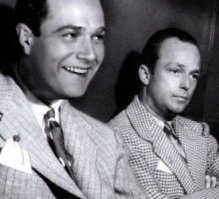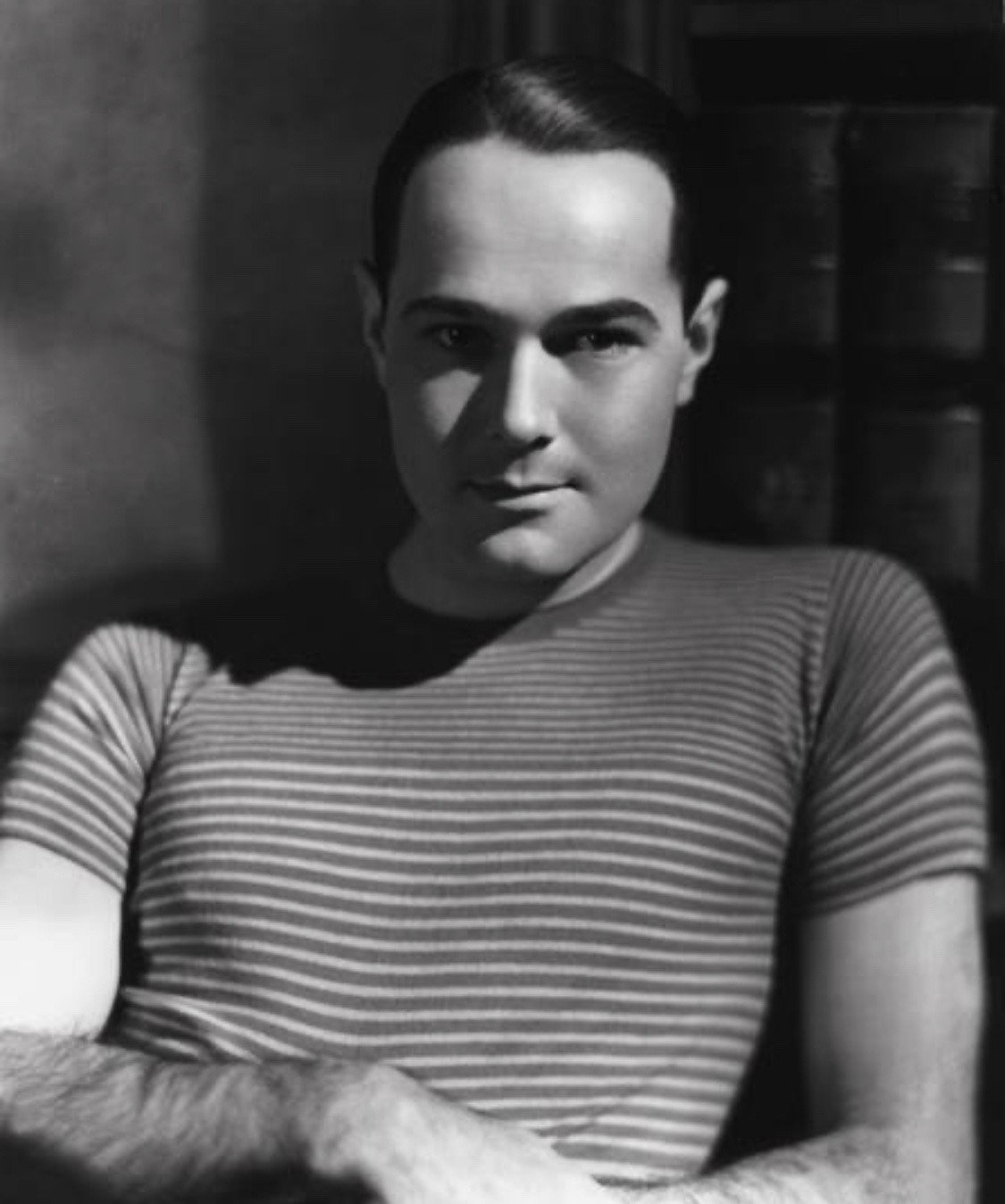"The Happiest Married Couple in Hollywood"
Haines & Shields
Hollywood’s Happiest Married Couple
During Hollywood’s “Golden Age” (c. 1920-1955) studios pretty much controlled the lives, destinies, family histories and even names of all the actors they had under contract at any given time. Have an obviously ethnic or unpronounceable name like Mischa Ounskowsky, Naftaly Birnbaum, Jacob Julius Garfinkle, Hedwig Eva Maria Kiesler or Simone Henriette Charlotte Kaminker? Well, with a mere snap of the finger and a couple of dozen press releases voila! - your studio had renamed you, in order, Mischa Auer, George Burns, John Garfield, Hedy Lamarr or Simone Signoret. Each star - or star-in-the-making - was assigned a P.R. agent whose job was to keep their name in the movie mags when things were good, and off the police blotters when they wound up in trouble. The studios also put their newcomers through a rigorous schedule of “schooling” in such varied areas as dancing, fencing, saddlery and, when talkies came in, singing.
Much of studio “puffery” (a quaint term for “B.S.”) informed the adoring movie-going public that their favorite stars were either descendants of Mayflower families, Ivy League educated, inveterate church-goers, or somehow related to European (most British) royalty. It goes without saying that much of what the public “knew” about these stars and starlets was pure twaddle. Beginning in the early 1920s, however, a series of scandals hit the film industry, effectively revealing that their idols had feet of clay. Gossip columnists, particularly those working for Hearst publications, gave a lurid accounting of the foibles and failings of their heroes. Soon, “blue-noses” and members of women’s clubs began pushing the studios to institute morality codes for both the people they employed and the films they made. Among the things the strait-laced noted and complained about most bitterly was that a vast number of these movie people were piling up marriages and divorces at an alarming rate. Quelle immoralité !
Truth to tell Hollywood has long suffered from an overabundance of monogamy . . . meaning too many people getting married far too often. Sometimes the marriages last but a few weeks or months; often they ended not in divorce, but in annulment. Among the marriage champs we find:
Lana Turner: 8 marriages (Her 1st, to bandmaster Artie Shaw [Arthur Jacob Arshawsky] last 1 day shy of 7 months); Shaw next married Ava Gardner; that marriage lasted precisely 1 year
Mickey Rooney: 8 (His first, to Ava Gardner, lasted a mere 26 months)
Judy Garland: 5
Rita Hayworth: 5 (including Orson Welles)
Clark Gable: 5
Humphrey Bogart: 4
Charlie Chaplin: 4 (all of whom were teenagers; in total, 2 of these wives presented him with 11 children; the first in 1925, the 11th in 1957)
John Barrymore: 4 (including the “love of his life,” the writer “Michael Strange.”)
As seemingly commonplace as this has been over the past century, there are also Hollywood couples whose marriages lasted far, far longer than most can imagine. Consider the following:
Norman and Peggy Lloyd (who was a friend of mine), were married for an amazing 75 years, 65 days.
Karl Malden and Mona Greenberg were married 70 years, 195 days.
Bob and Delores Hope were married for 69 years, 5 months.
Kirk and Anne Bydens Douglas were married 65 years 253 days.
Cyd Charrise and Tony Martin (Alvin Morris) were married 60 years, 34 days.
Alan Alda and Arlene Weiss will be celerating their 66th anniversary on March 15.
Sir Alfred Hitchcock and Alma Reville, were married for nearly 54 years.
Dawn Nickerson (my dear friend and student) ) and Richart L. Fox , Sr. were married for 48 years.
(IT SHOULD also BE noted that our parents, Alice K. and Henry E. Stone were married for 59 years. In many ways bipolar opposites, dad never missed a chance to usher at any of Madame’s performances. They proved how different they were at a 50th anniversary gathering (at the Sportsman’s Lodge), where my father gave a loving, romantic toast to his bride (which had most of the women wishing their husband’s were so articulate) and mom, responding in her 30 megawatt voice proclaiming : “HERE’S TO HENRY. FIFTY YEARS OF MARRIAGE AND NEVER ONCE CONSIDERED DIVORCE. Then, pausing for a perfect amount of time continued . . . “MURDER? MANY TIMES!”).
Returning to the opening paragraphs of this post, it should be noted that in Hollywood - a truly small town in every sense of the term - most everyone knew who their neighbors were in real life . . . behind the silver, P.R.-created curtain of fiction. We knew who drank too much and who was popping pills, who was gay and who was an uneducated jerk. And for the most part, it really didn’t matter. One of the things that made growing up in that world so different (although as kids we did not know it) was how accepting most of us were taught to be.
Continuing with the “marriage thread,” everyone knew that the actor William (“Billy”) Haines and his lifetime companion James “Jimmy” Shields were an ideal couple. The two met in New York even before the Virginia-born Billy first hit Hollywood in the early 1920s. It didn’t take long for Billy to become a major star; the picture which first brought him to the attention of the movie-going public was 1926’s Brown of Harvard. in which Billy played a supremely confident, wisecracking player on the football team. This would be the personality - that of a wise-acre - which brought him to public acclaim. So much so that by the late 1920s, he was the #1 box office attraction in the United States, making more than $1 million dollars a year and costarring with the likes of Marion Davies, Joan Crawford, Lon Chaney, and Lionel Barrymore. His best picture, in my estimation, was 1928’s Show People, costarring Marion Davies (also her best picture) and directed by one of Hollywood’s all-time greatest directors, King Vidor. In this late silent film, Billy plays movie comic Billy Boone, who is in love with up-and-coming actress Peggy Pepper (Davies) who, taking herself oh-so-seriously, transforms herself into “Patricia Pepoire,” the cinematic ancestor of Jean Hagen’s character “Lina Lamont,” in 1952’s Singin’ in the Rain.
William Haines at His Peak
Unlike stars Ramon Navarro, Greta Garbo, comedienne Patsy Kelley and directors Dorothy Arzner and George Cukor, of whom the movie-going public knew nothing vis-a-vis their proclivities, Hollywood was completely aware - and by a wide margin accepting - of their sexuality. Indeed, for many years, director George Cukor (1899-1983) was well-known in Hollywood for the legendary Sunday afternoon poolside Sunday brunches he would put on at his opulent home at 9166 Cordell Drive in Beverly Hills. These gatherings included the best and brightest of the Hollywood homosexual underground. In time to come, Billy and Jimmy would serve as the interior designers of Cukor’s home.
The advent of talking motion pictures threw a monkey wrench into the industry; all sorts of changes began to occur. Stars like Vilma Banky, Karl Dane and Emil Jannings were let go because their European accents were impossible to understand. Others, like top-flight stars Clara Bow and Norma Talmadge with their heavy Brooklyn “toidy-toid-and-toid” patois simply could not make it in the talkies.
Pronunciation aside, MGM head Louis B. Mayer had another problem with William Haines; one which had nothing to do with his pronunciation. Meyer told Haines, (the first proudly self-outed actor in Hollywood), know in no uncertain terms that if he were to continue earning his millions, he would first have to part company with Jimmy Shields (whom he had been with, by this time for nearly a decade) and enter into a “Lavendar” marriage . . . one with a woman, for the sake of publicity. Haines refused Mayer’s ultimatum, thereby forsaking his movie career for the man he loved. Mayer was one problem for Haines; the other was the Hays Production Code, which in 1930, imposed a set of “moral” guidelines that actors were commanded to obey. One was an absolute prohibition on "homosexual behavior" - both onscreen and off. At the peak of his stardom, Haines was able to have the clause removed from his contract and continue acting. But when several of his movies didn’t perform well at the box office, - including the overtly “swishy” 1930 film Way Out West, there was mounting pressure to conform.
Winfield House
A few years before being dropped by MGM, Haines had become part-owner of an antiques store on La Brea Avenue. He had an excellent eye and his home at 1712 Stanley Ave. (called the "Haines Castle) was a designer showcase. He was best friends with Joan Crawford (whom he had nicknamed “Raspberries”) and welcomed into the inner circle of William Randolph Hearst and Marion Davies, attending their famous parties in San Simeon. Thanks to these and many other connections, Haines became Hollywood’s most in-demand decorator. Crawford was one of his first clients, followed by Tallulah Bankhead, Jack Warner, Betsy Bloomingdale, and, as mentioned above, director George Cukor. Without question, the pinnacle of Billy and Jimmy’s decorating career was their 1968 redecorating of Winfield House, the lavish residence of America’s Ambassador to the Court of St. James . . . who at the time was publishing magnate Walter Annenberg.
Beyond his distinguished clientele, Billy Haines became synonymous with good taste in Hollywood. Gone were the dark, moody interiors, the leopard print rugs, the garish purchases made by rising stars suddenly flush with cash. In their places, he hung hand-painted wallpaper, refined low seating, chinoiserie, and English antiques; all harbingers of what we now call Hollywood Regency. Hollywood directors incorporated Haines’s aesthetic into their films, often literally: Billy and Jimmy’s personal art collection was hung on the walls of Tara in Gone with the Wind. Nancy and Ronald Reagan were also fans, and Haines decorated their home in Pacific Palisades when Reagan became governor of California (after he retired, his protegé Ted Graber decorated the Reagan White House).
It was Joan Crawford who first referred to Billy and Jimmy as “Hollywood’s happiest couple.” In many respects, like many happily married couples, they were a study in opposites: Billy was always “on,” while Jimmy was quiet. One was a born entertainer, the other more of a homebody. And yet, it worked admirably well for nearly a half century. There are very, very few pictures of the two together - either at home or in public. What few exist are mostly from their later years . . . with the exception of the rare photo above at the beginning of this post.
But alas, nothing lasts for ever. Billy died of lung cancer in Santa Monica on December 26, 1973; he was 73 years old. 10 weeks later - March 6, 1974, Jimmy Shields put on a pair of Billy’s favorite pajamas, climbed into their bed, took an overdose of sleeping pills, and passed away. His suicide note said, simply, "Goodbye to all of you who have tried so hard to comfort me in my loss of William Haines, whom I have been with since 1926. I now find it impossible to go it alone, I am much too lonely."
They are interred side by side in Woodlawn Memorial Cemetery in Santa Monica, California. William Haines Designs remains in operation, with main offices in West Hollywood and an additional showroom in New York. Playwright Claudio Macor created the biographical drama The Tailor-Made Man in the mid-1990s in London, telling the story of Haines' discovery in a talent contest, his movie career, its curtailment by Louis B. Mayer, and Haines' re-invention as an interior designer. The 50-year marriage of Billy and Jimmy is, of course, a major theme of this work . . . which is only fitting for Hollywood’s happiest married couple . . .
Copyright®2023 Kurt F. Stone



